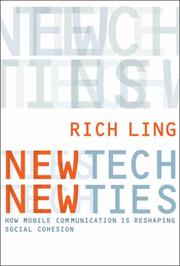| Listing 1 - 4 of 4 |
Sort by
|
Book
ISBN: 026233092X 9780262330923 0262029634 9780262029636 0262330938 9780262533591 0262533596 Year: 2015 Publisher: Cambridge, Massachusetts
Abstract | Keywords | Export | Availability | Bookmark
 Loading...
Loading...Choose an application
- Reference Manager
- EndNote
- RefWorks (Direct export to RefWorks)
Drawing on unprecedented access to a vast array of primary sources and interviews with nearly every influential design leader, this thought provoking book reveals design to be the missing link in Silicon Valley's ecosystem of innovation. --
Industrial design --- Design, Industrial --- History. --- Social aspects --- Mechanical drawing --- New products --- Design --- History --- Social aspects&delete& --- E-books --- DESIGN/General --- COMPUTER SCIENCE/Human Computer Interaction --- DIGITAL HUMANITIES & NEW MEDIA/New Media History

ISBN: 0262122979 9786612099304 0262278413 1282099302 1435628020 9780262278416 9781435628021 9780262122979 9781282099302 6612099305 026226093X 9780262260930 Year: 2008 Publisher: Cambridge, Mass. : MIT Press,
Abstract | Keywords | Export | Availability | Bookmark
 Loading...
Loading...Choose an application
- Reference Manager
- EndNote
- RefWorks (Direct export to RefWorks)
How cell phones and mobile communication may in many cases strengthen social cohesion.
LANGUAGE ARTS & DISCIPLINES --- Communication Studies --- Cell phones --- Interpersonal communication --- Communication and culture --- Transportation Economics --- Business & Economics --- Social aspects --- Technological innovations --- Communication and culture. --- Social aspects. --- Culture and communication --- Culture --- Communication --- Interpersonal relations --- Technological innovations&delete& --- E-books --- DIGITAL HUMANITIES & NEW MEDIA/General --- INFORMATION SCIENCE/Communications & Telecommunications --- SOCIAL SCIENCES/Media Studies
Book
ISBN: 9780262018135 0262018136 0262305267 0262304341 1283741598 9780262304344 9780262305266 9780262304344 9780262306188 0262306182 Year: 2012 Publisher: Cambridge, Mass. The MIT Press
Abstract | Keywords | Export | Availability | Bookmark
 Loading...
Loading...Choose an application
- Reference Manager
- EndNote
- RefWorks (Direct export to RefWorks)
Why do we feel insulted or exasperated when our friends and family don't answer their mobile phones? If the Internet has allowed us to broaden our social world into a virtual friend-net, the mobile phone is an instrument of a more intimate social sphere. The mobile phone provides a taken-for-granted link to the people to whom we are closest; when we are without it, social and domestic disarray may result. In just a few years, the mobile phone has become central to the functioning of society. In this book, Rich Ling explores the process by which the mobile phone has become embedded in society, comparing it to earlier technologies that changed the character of our social interaction and, along the way, became taken for granted. Ling, drawing on research, interviews, and quantitative material, shows how the mobile phone (and the clock and the automobile before it) can be regarded as a social mediation technology, with a critical mass of users, a supporting ideology, changes in the social ecology, and a web of mutual expectations regarding use. By examining the similarities and synergies among these three technologies, Ling sheds a more general light on how technical systems become embedded in society and how they support social interaction within the closest sphere of friends and family
Cell phones --- Mobile communication systems --- Interpersonal communication --- Communication and culture. --- Téléphone cellulaire --- Radiocommunications mobiles --- Communication interpersonnelle --- Communication et culture --- Social aspects. --- Technological innovations --- Aspect social --- Innovations --- Téléphone cellulaire --- Mass communications --- Communication and culture --- Social aspects --- Technological innovations&delete& --- E-books --- Culture and communication --- Culture --- Communication --- Interpersonal relations --- Vehicles --- Vehicular communication systems --- Radio --- Wireless communication systems --- Communication systems --- DIGITAL HUMANITIES & NEW MEDIA/General --- SCIENCE, TECHNOLOGY & SOCIETY/General --- SOCIAL SCIENCES/Media Studies
Book
ISBN: 9781942401346 9781942401353 1942401353 1641899441 1942401345 Year: 2018 Publisher: Arc Humanities Press
Abstract | Keywords | Export | Availability | Bookmark
 Loading...
Loading...Choose an application
- Reference Manager
- EndNote
- RefWorks (Direct export to RefWorks)
In this unique collection the authors present a wide range of interdisciplinary methods to study, document, and conserve material cultural heritage. The methods used serve as exemplars of best practice with a wide variety of cultural heritage objects having been recorded, examined, and visualised. The objects range in date, scale, materials, and state of preservation and so pose different research questions and challenges for digitization, conservation, and ontological representation of knowledge. Heritage science and specialist digital technologies are presented in a way approachable to non-scientists, while a separate technical section provides details of methods and techniques, alongside examples of notable applications of spatial and spectral documentation of material cultural heritage, with selected literature and identification of future research. This book is an outcome of interdisciplinary research and debates conducted by the participants of the COST Action TD1201, Colour and Space in Cultural Heritage, 2012-16 and is an Open Access publication available under a CC BY-NC-ND licence.
Museology --- Information systems --- digital preservation --- tangible cultural heritage --- conservation science [cultural heritage discipline] --- Cultural property --- Historic preservation --- Digital preservation --- Computer files --- Digital curation --- Digital media --- Electronic preservation --- Preservation of digital information --- Preservation of materials --- Preservation, Historic --- Preservationism (Historic preservation) --- Cultural heritage --- Cultural patrimony --- Cultural resources --- Heritage property --- National heritage --- National patrimony --- National treasure --- Patrimony, Cultural --- Treasure, National --- Property --- World Heritage areas --- Digitization --- Protection&delete& --- Technological innovations --- Conservation and restoration --- Preservation --- Protection --- E-books --- Digital preservation. --- Digitization. --- Technological innovations. --- Cultural heritage. --- Digital Humanities. --- Documentation. --- Science.
| Listing 1 - 4 of 4 |
Sort by
|

 Search
Search Feedback
Feedback About UniCat
About UniCat  Help
Help News
News